Answered step by step
Verified Expert Solution
Question
1 Approved Answer
will you please answer these questions for this case? I would be appreciated. 2:101-3: 1O 1 INTEGRATIVE CASE 1.1 Walmart The first case at the
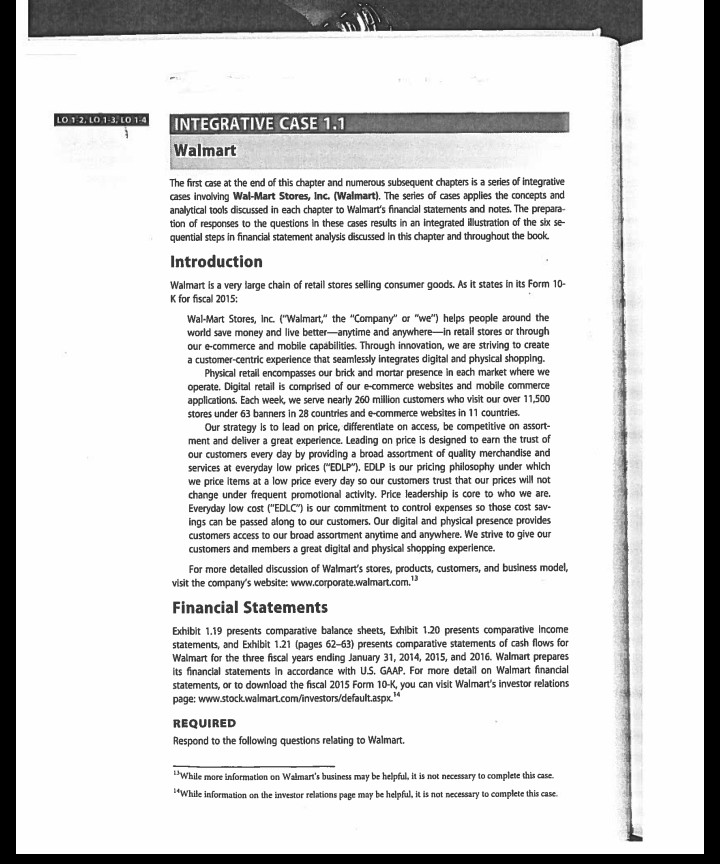
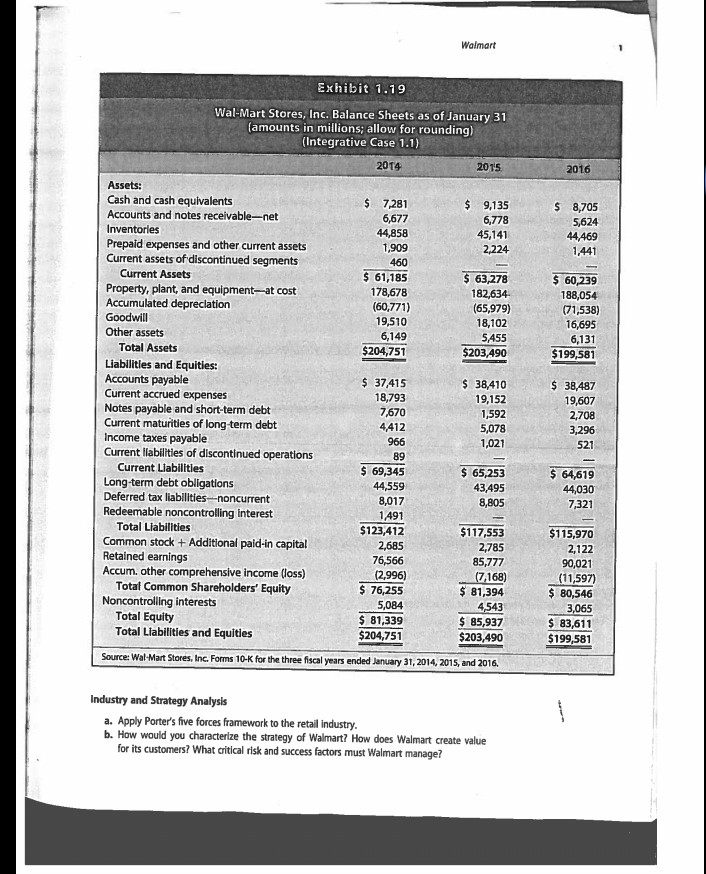
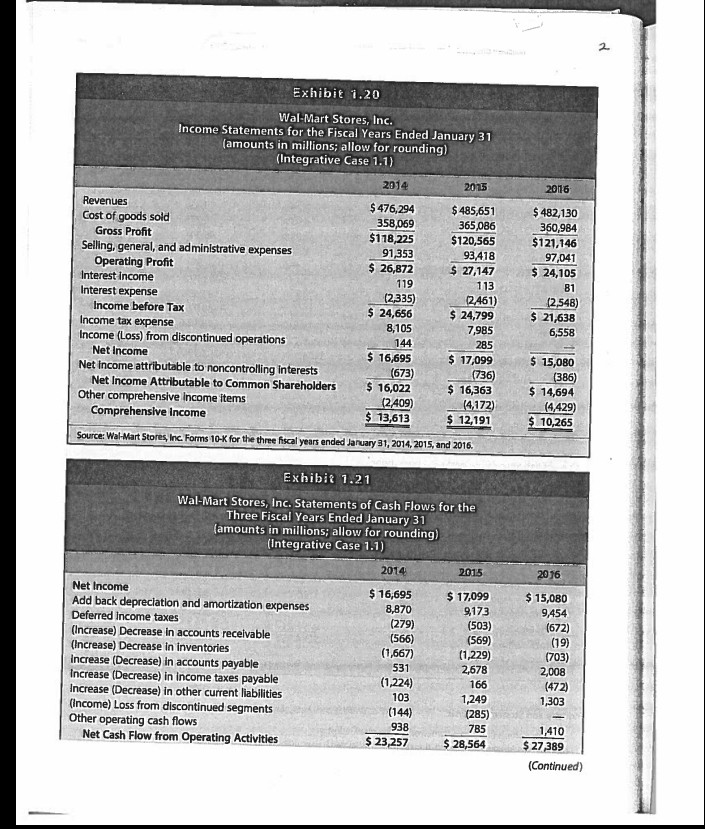
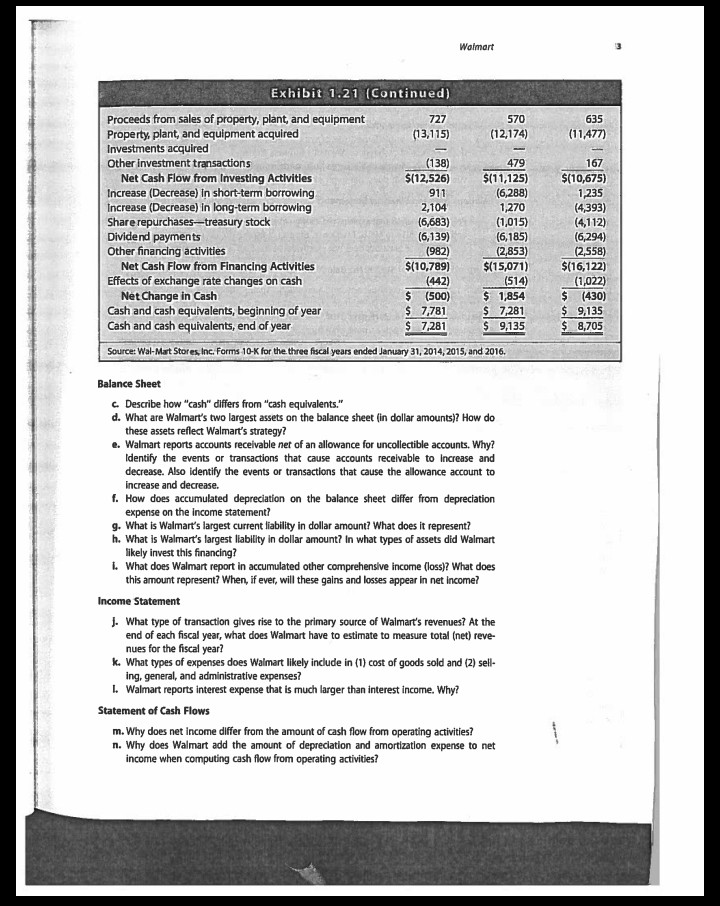
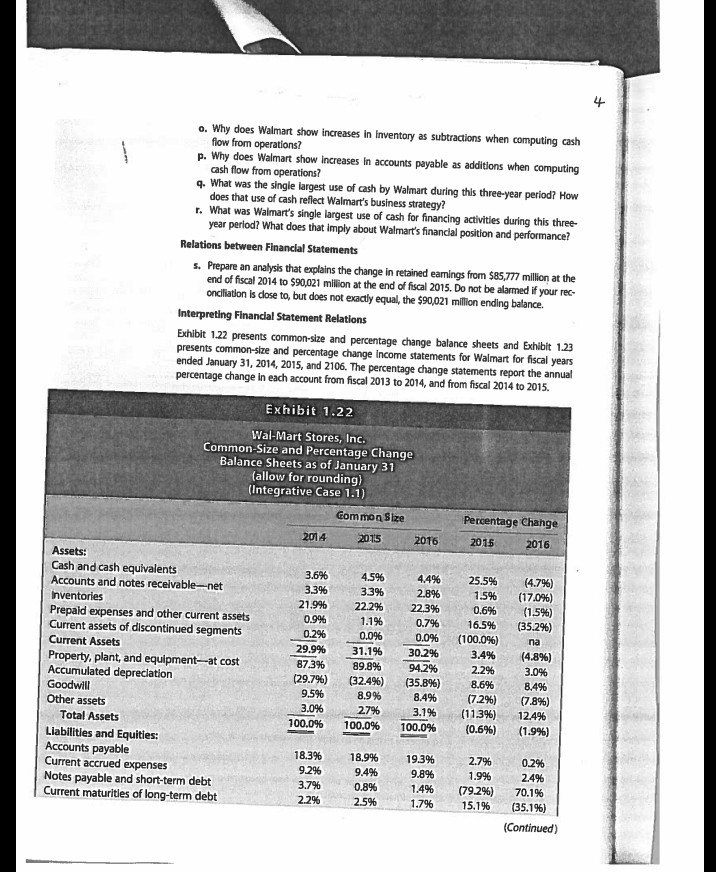
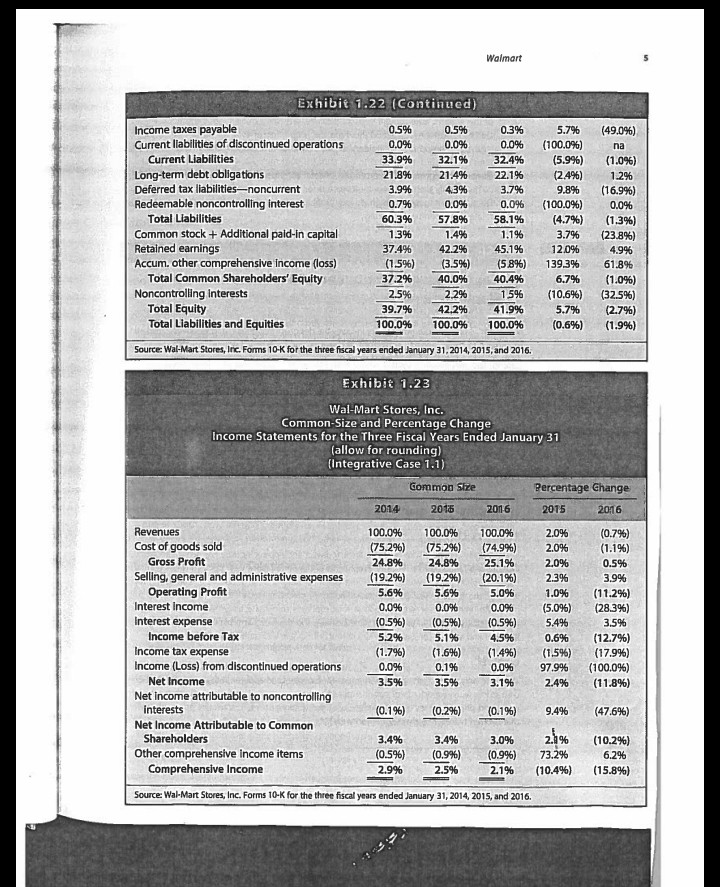
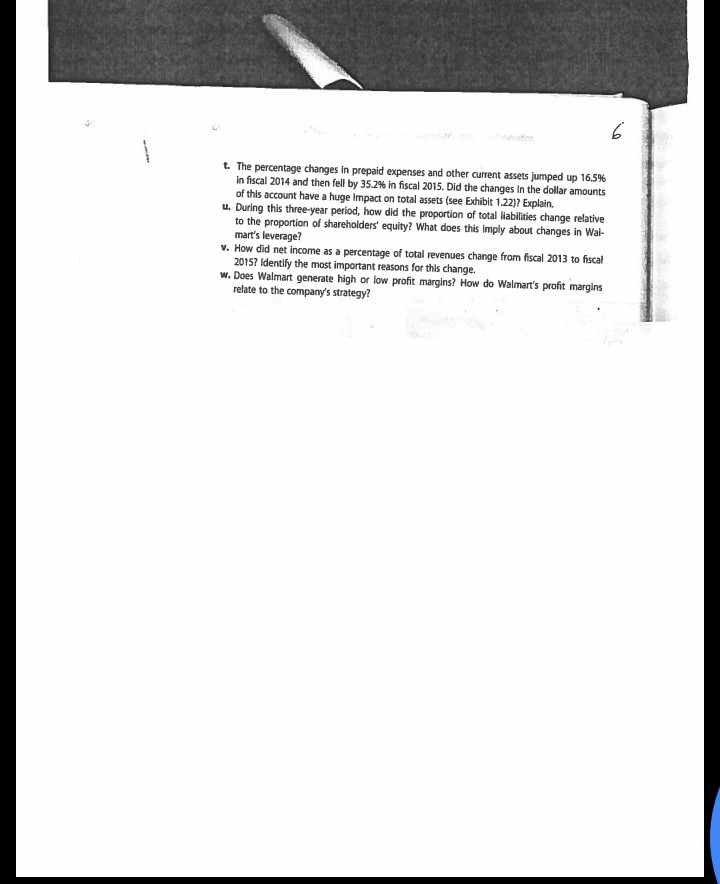
will you please answer these questions for this case? I would be appreciated.
2:101-3: 1O 1 INTEGRATIVE CASE 1.1 Walmart The first case at the end of this chapter and numerous subsequent chapters is a series of integrative cases involving Wal-Mart Stores, Inc. (Walmart). The series of cases applies the concepts and analytical tools discussed in each chapter to Walmart's financial statements and notes. The prepara- tion of responses to the questions in these cases results in an integrated Hlustration of the six se- quential steps in financial statement analysis discussed in this chapter and throughout the book Introduction Walmart is a very large chain of retail stores selling consumer goods. As it states in its Form 10- K for fiscal 2015: Wal-Mart Stores,c. Walmart," the "Company" or "we) helps people around the world save money and live better-anytime and anywhere-in retail stores or through our e-commerce and mobile capabilities. Through innovation, we are striving to create a customer-centric experience that seamlessly integrates digital and physical shopping. Physical retall encompasses our brick and mortar presence in each market where we operate. Digital retail is comprised of our e-commerce websites and mobile commerce applications. Each week, we serve nearly 260 million customers who visit our over 11,500 stores under 63 banners in 28 countries and e-commerce websites in 11 countries. Our strategy Is to lead on price, differentiate on access, be competitive on assort- ment and deliver a great experience. Leading on price is designed to earn the trust of our customers every day by providing a broad assortment of quality merchandise and services at everyday low prices ("EDLP). EDLP is our pricing philosophy under which we price items at a low price every day so our customers trust that our prices will not change under frequent promotional activity. Price leadership is core to who we are. Everyday low cost ("EDLC") is our commitment to control expenses so those cos sav- ings can be passed along to our customers. Our digital and physical presence provides customers access to our broad assortment anytime and anywhere. We strive to give our customers and members a great digital and physical shopping experience. For more detalled discussion of Walmart's stores, products, customers, and business model, visit the company's website: www.corporate.walmart.com. Financial Statements Exhibit 1.19 presents comparative balance sheets, Exhlbit 1.20 presents comparative Income statements, and Exhibit 121 (pages 62-63) presents comparative statements of cash flows for Walmart for the three fiscal years ending January 31, 2014, 2015, and 2016. Walmart prepares its financial statements in accordance with US, GAAP. For more detail on Walmart financial statements, or to download the fiscal 2015 Form 10-K, you can visit Walmart's investor relations page: www.stock REQUIRED Respond to the following questions relating to Walmart. UWhile more information on Walmart's business may be helpful, it is not necessary to complete this case. While information on the investor relations page may be helpful, it is not necessary to complete this case Exhibit 1.19 Wal-Mart Stores, Inc. Balance Sheets as of January 31 (amounts in millions; allow for rounding) (Integrative Case 1.1) 2014 2015 2016 Assets: Cash and cash equivalents Accounts and notes receivable-net Inventorles Prepaid expenses and other current assets Current assets of discontinued segments $ 7281 6,677 44,858 $ 9,135 6,778 45,141 5,624 44469 441 460 61,185 178,678 (60,771) 19,510 6,149 63,278 60239 Current Assets Property, plant, and equipment-at cost Accumulated depreclation Goodwill Other assets 182,634 (65,979) 18,102 5A55 188,054 71,538) 6,131 $199,581 Total Assets 520475103490 199 581 $203,490 Liabilitiles and Equities: Accounts payable Current accrued expenses Notes payable and short-term debt Current maturities of long term debt Income taxes payable Current labilities of discontinued operations 37415 38,410 $ 38,487 19,607 2,708 3,296 19,152 1,592 7,670 4412 966 89 69,345 44,559 8,017 1491 123,412 2,685 76,566 (2,996) 76,255 5,084 81,339 $204,751 1,021 65253 64,619 Current Liabilities Long-term debt obligations Deferred tax liabilities -noncurrent Redeemable noncontrolling interest 43,495 8,805 44,030 7321 Total Liabilities Common stock +Additional paid-in capital Retained earnings Accum. other comprehensive income (loss) 117.553 2,785 85,777 115,970 2,122 90,021 Total Common Shareholders' Equity 81,394 4,543 $85,937 $203,490 80,546 Noncontroliling interests Total Equity Total Liabilities and Equities 83,611 $199,581 Source: Wal-Mart Stores, Inc. Forms 10-K for the three fiscal years ended January 31, 2014, 2015, and 2016 Industry and Strategy Analysis a. Apply Porter's five forces framework to the retail industry b. How would you characterize the strategy of Walmart? How does Walmart create value for its customers? What critical risk and success factors must Walmart manage? Walmart Exhibit 1.22 (continued) Income taxes payable Current liabilities of discontinued operations 0.5% 0.0% 33.9% 21.8% 3.9% 0.7% 60.3% 1.3% 37.4% (15%) 37.2% 25% 39.7% 100.0% 0.5% 0.0% 32.1% 21.4% 43% 0.0% 57.8% 1.4% 42.2% (3.5%) 40.0% 2.2% 42.2% 100.0% 0.3% 0.0% 32.4% 22.1% 3.7% 0.0% 58.1% 1.1% 45.1% (58%) 40.4% 1596 41.9% 100.0% 5.7% (100.0%) (5.996) (2.4%) 9.3% (100.0%) (4.796) 3.7% 12.0% 139.3% 6.7% (10.6%) 5.7% (0.6%) (49.0%) na (1.096) 12% (16.9%) 0.0% (1.396) (23.8%) 4.9% 61.8% (1.0%) (32.5%) (2.7%) (1996) Current Liabilities Long-term debt obligations Deferred tax liabilities-noncurrent Redeemable noncontrolling interest Total Liabilities Common stock+ Additional paid-in capital Retained earnings Accum. other comprehensive income (loss) Total Common Shareholders' Equity Noncontroling interests Total Equity Total Liabilities and Equities Source: Wal-Mart Stores, Irc. Forms 10-K for the three fiscal years ended January 31.2014,2015, and 2016 Exhibit 1.23 Wal-Mart Stores, Inc Common-Size and Percentage Change Income Statements for the Three Fiscal Years Ended January 31 allow for rounding) integrative Case 1.1) Common Size Percentage Change 2014 20 2016 2015 2016 Revenues Cost of goods sold 100096 (75296) 24.8% (19.2%) 5.6% 0.0% 0.596) 5.2% (1.7%) 0.0% 3.5% 100096 (75296) 24.8% (19.2%) 5.6% 0.0% (0.596) 5.1% (1.6%) 0.1% 3.5% 100096 (74.9%) 25.1% (20.1%) 5.0% 0.0% (0.5%) 4.5% (1.4%) 0.0% 3.1% 2.0% 2.0% 2.0% 23% 1.0% (5.0%) 54% 0.6% (1.5%) 97.9% 2.4% (0.7%) (1.1%) 0.5% 3.9% (11.2%) (28.3%) 3.5% (12.7%) (17.996) (100.0%) (11.8%) Gross Profit Selling, general and administrative expenses Operating Profit Interest income interest expense Income before Tax Income tax expense Income (Loss) from discontinued operations Net income attributable to noncontrolling Net Income Attributable to Common Other comprehensive income items Net Income interests Shareholders (0.1%) (0296) (0.1%) 9.496 (47.6%) 3.4% (0.5%) 2.9% 3.4% (0.996) 2.5% 3.0% (0.996) 2.1% 2.1% 73.2% (10.4%) (10.2%) 6.2% (15.8%) Comprehensive Income Source: Wal-Mart Stores, Inc. Forms 10-K for the three fiscal years ended January 31, 2014, 2015, and 2016. t. The percentage changes in prepaid expenses and other current assets jumped up 165% in fiscal 2014 and then fell by 35.2% in fiscal 2015, Did the changes in the dolar amounts of this account have a huge impact on total assets (see Exhibit 1.22)? Explain. to the proportion of shareholders' equity? What does this imply about changes in Wal- u. During this three-year period, how did the proportion of total liabilities change relative mart's leverage? 20157 Identify the most important reasons for this change. relate to the company's strategy? v. How did net income as a percentage of total revenues change from fiscal 2013 to fiscal W. Does Walmart generate high or low profit margins? How do Walmart's proft margins 2:101-3: 1O 1 INTEGRATIVE CASE 1.1 Walmart The first case at the end of this chapter and numerous subsequent chapters is a series of integrative cases involving Wal-Mart Stores, Inc. (Walmart). The series of cases applies the concepts and analytical tools discussed in each chapter to Walmart's financial statements and notes. The prepara- tion of responses to the questions in these cases results in an integrated Hlustration of the six se- quential steps in financial statement analysis discussed in this chapter and throughout the book Introduction Walmart is a very large chain of retail stores selling consumer goods. As it states in its Form 10- K for fiscal 2015: Wal-Mart Stores,c. Walmart," the "Company" or "we) helps people around the world save money and live better-anytime and anywhere-in retail stores or through our e-commerce and mobile capabilities. Through innovation, we are striving to create a customer-centric experience that seamlessly integrates digital and physical shopping. Physical retall encompasses our brick and mortar presence in each market where we operate. Digital retail is comprised of our e-commerce websites and mobile commerce applications. Each week, we serve nearly 260 million customers who visit our over 11,500 stores under 63 banners in 28 countries and e-commerce websites in 11 countries. Our strategy Is to lead on price, differentiate on access, be competitive on assort- ment and deliver a great experience. Leading on price is designed to earn the trust of our customers every day by providing a broad assortment of quality merchandise and services at everyday low prices ("EDLP). EDLP is our pricing philosophy under which we price items at a low price every day so our customers trust that our prices will not change under frequent promotional activity. Price leadership is core to who we are. Everyday low cost ("EDLC") is our commitment to control expenses so those cos sav- ings can be passed along to our customers. Our digital and physical presence provides customers access to our broad assortment anytime and anywhere. We strive to give our customers and members a great digital and physical shopping experience. For more detalled discussion of Walmart's stores, products, customers, and business model, visit the company's website: www.corporate.walmart.com. Financial Statements Exhibit 1.19 presents comparative balance sheets, Exhlbit 1.20 presents comparative Income statements, and Exhibit 121 (pages 62-63) presents comparative statements of cash flows for Walmart for the three fiscal years ending January 31, 2014, 2015, and 2016. Walmart prepares its financial statements in accordance with US, GAAP. For more detail on Walmart financial statements, or to download the fiscal 2015 Form 10-K, you can visit Walmart's investor relations page: www.stock REQUIRED Respond to the following questions relating to Walmart. UWhile more information on Walmart's business may be helpful, it is not necessary to complete this case. While information on the investor relations page may be helpful, it is not necessary to complete this case Exhibit 1.19 Wal-Mart Stores, Inc. Balance Sheets as of January 31 (amounts in millions; allow for rounding) (Integrative Case 1.1) 2014 2015 2016 Assets: Cash and cash equivalents Accounts and notes receivable-net Inventorles Prepaid expenses and other current assets Current assets of discontinued segments $ 7281 6,677 44,858 $ 9,135 6,778 45,141 5,624 44469 441 460 61,185 178,678 (60,771) 19,510 6,149 63,278 60239 Current Assets Property, plant, and equipment-at cost Accumulated depreclation Goodwill Other assets 182,634 (65,979) 18,102 5A55 188,054 71,538) 6,131 $199,581 Total Assets 520475103490 199 581 $203,490 Liabilitiles and Equities: Accounts payable Current accrued expenses Notes payable and short-term debt Current maturities of long term debt Income taxes payable Current labilities of discontinued operations 37415 38,410 $ 38,487 19,607 2,708 3,296 19,152 1,592 7,670 4412 966 89 69,345 44,559 8,017 1491 123,412 2,685 76,566 (2,996) 76,255 5,084 81,339 $204,751 1,021 65253 64,619 Current Liabilities Long-term debt obligations Deferred tax liabilities -noncurrent Redeemable noncontrolling interest 43,495 8,805 44,030 7321 Total Liabilities Common stock +Additional paid-in capital Retained earnings Accum. other comprehensive income (loss) 117.553 2,785 85,777 115,970 2,122 90,021 Total Common Shareholders' Equity 81,394 4,543 $85,937 $203,490 80,546 Noncontroliling interests Total Equity Total Liabilities and Equities 83,611 $199,581 Source: Wal-Mart Stores, Inc. Forms 10-K for the three fiscal years ended January 31, 2014, 2015, and 2016 Industry and Strategy Analysis a. Apply Porter's five forces framework to the retail industry b. How would you characterize the strategy of Walmart? How does Walmart create value for its customers? What critical risk and success factors must Walmart manage? Walmart Exhibit 1.22 (continued) Income taxes payable Current liabilities of discontinued operations 0.5% 0.0% 33.9% 21.8% 3.9% 0.7% 60.3% 1.3% 37.4% (15%) 37.2% 25% 39.7% 100.0% 0.5% 0.0% 32.1% 21.4% 43% 0.0% 57.8% 1.4% 42.2% (3.5%) 40.0% 2.2% 42.2% 100.0% 0.3% 0.0% 32.4% 22.1% 3.7% 0.0% 58.1% 1.1% 45.1% (58%) 40.4% 1596 41.9% 100.0% 5.7% (100.0%) (5.996) (2.4%) 9.3% (100.0%) (4.796) 3.7% 12.0% 139.3% 6.7% (10.6%) 5.7% (0.6%) (49.0%) na (1.096) 12% (16.9%) 0.0% (1.396) (23.8%) 4.9% 61.8% (1.0%) (32.5%) (2.7%) (1996) Current Liabilities Long-term debt obligations Deferred tax liabilities-noncurrent Redeemable noncontrolling interest Total Liabilities Common stock+ Additional paid-in capital Retained earnings Accum. other comprehensive income (loss) Total Common Shareholders' Equity Noncontroling interests Total Equity Total Liabilities and Equities Source: Wal-Mart Stores, Irc. Forms 10-K for the three fiscal years ended January 31.2014,2015, and 2016 Exhibit 1.23 Wal-Mart Stores, Inc Common-Size and Percentage Change Income Statements for the Three Fiscal Years Ended January 31 allow for rounding) integrative Case 1.1) Common Size Percentage Change 2014 20 2016 2015 2016 Revenues Cost of goods sold 100096 (75296) 24.8% (19.2%) 5.6% 0.0% 0.596) 5.2% (1.7%) 0.0% 3.5% 100096 (75296) 24.8% (19.2%) 5.6% 0.0% (0.596) 5.1% (1.6%) 0.1% 3.5% 100096 (74.9%) 25.1% (20.1%) 5.0% 0.0% (0.5%) 4.5% (1.4%) 0.0% 3.1% 2.0% 2.0% 2.0% 23% 1.0% (5.0%) 54% 0.6% (1.5%) 97.9% 2.4% (0.7%) (1.1%) 0.5% 3.9% (11.2%) (28.3%) 3.5% (12.7%) (17.996) (100.0%) (11.8%) Gross Profit Selling, general and administrative expenses Operating Profit Interest income interest expense Income before Tax Income tax expense Income (Loss) from discontinued operations Net income attributable to noncontrolling Net Income Attributable to Common Other comprehensive income items Net Income interests Shareholders (0.1%) (0296) (0.1%) 9.496 (47.6%) 3.4% (0.5%) 2.9% 3.4% (0.996) 2.5% 3.0% (0.996) 2.1% 2.1% 73.2% (10.4%) (10.2%) 6.2% (15.8%) Comprehensive Income Source: Wal-Mart Stores, Inc. Forms 10-K for the three fiscal years ended January 31, 2014, 2015, and 2016. t. The percentage changes in prepaid expenses and other current assets jumped up 165% in fiscal 2014 and then fell by 35.2% in fiscal 2015, Did the changes in the dolar amounts of this account have a huge impact on total assets (see Exhibit 1.22)? Explain. to the proportion of shareholders' equity? What does this imply about changes in Wal- u. During this three-year period, how did the proportion of total liabilities change relative mart's leverage? 20157 Identify the most important reasons for this change. relate to the company's strategy? v. How did net income as a percentage of total revenues change from fiscal 2013 to fiscal W. Does Walmart generate high or low profit margins? How do Walmart's proft marginsStep by Step Solution
There are 3 Steps involved in it
Step: 1

Get Instant Access to Expert-Tailored Solutions
See step-by-step solutions with expert insights and AI powered tools for academic success
Step: 2

Step: 3

Ace Your Homework with AI
Get the answers you need in no time with our AI-driven, step-by-step assistance
Get Started


